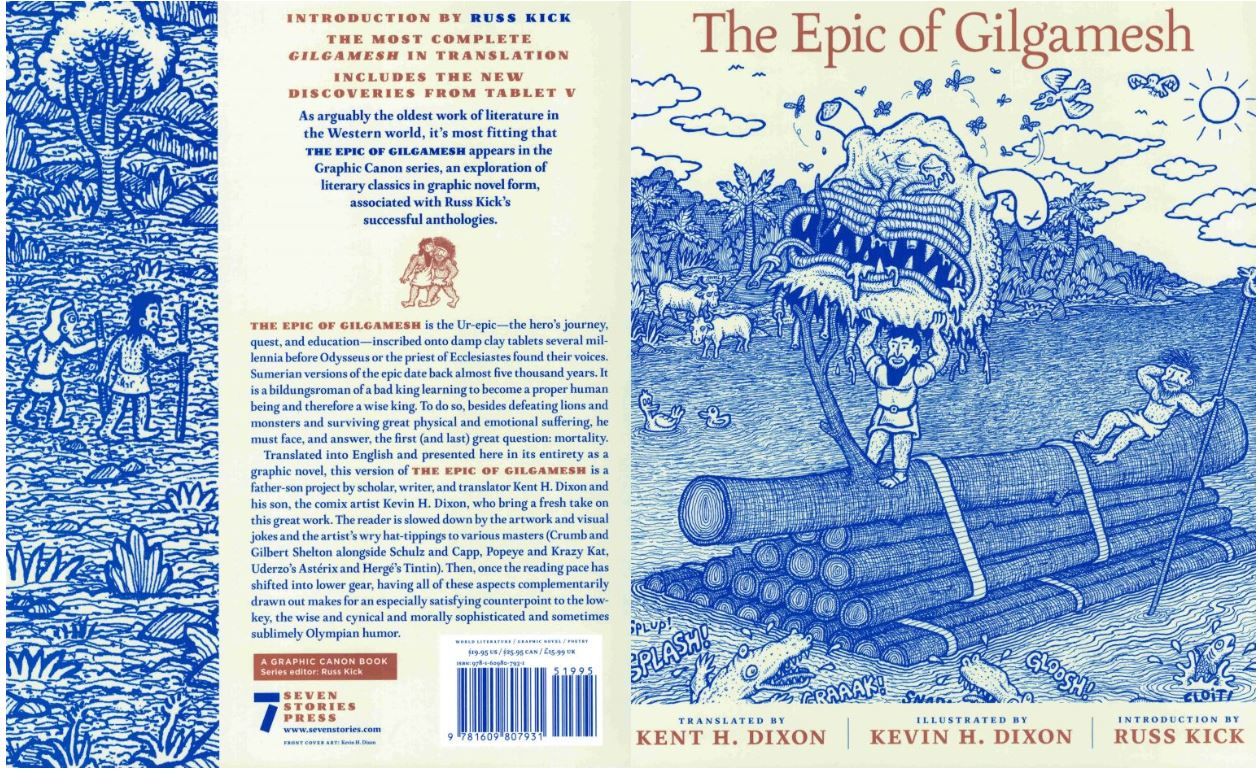
Translated by Kent H. Dixon & illustrated by Kevin H. Dixon (Seven Stories Press)
ISBN: 978-1-60980-793-1 (TPB): 978-1-60980-794-8 (eBook)
The infinite realm of comics is the most expansive medium we have for extolling heroic deeds, combining a facility for depicting all aspects of character with an unlimited budget for special effects; all whilst communicating instantaneous visceral understanding and appreciation to and on the part of the audience.
Such was not always the case: once upon a time all we had was words, originally spoken or chanted but eventually translated into permanent marks on durable surfaces.
As of this writing, The Epic of Gilgamesh is still the oldest known work of human literature. A truly timeless heroic saga, its earliest incarnation is actually five Sumerian poems lauding the accomplishments of Bilgamesh, King of Uruk, dating from the Third Dynasty of Ur. That’s approximately 2100 BCE as you, I and most modern Mesopotamians would reckon it.
As is so often the case, some smart wordsmith long ago appropriated the texts and reconditioned the snippets into something grander, with the saga surviving into our era via a series (still incomplete) of Babylonian tablets. The material is open to frequent interpretation and has been translated into many languages since first discovered.
What source material we have comes from tablets of cuneiform logographs discovered back in 1853 by Hormuzd Rassam amidst the remains of the Library of Ashurbanipal in Nineveh (near modern Mosul in Iraq). In the early 1870s western historian George Smith published his first translation and, after more hands-on study and research, a full and final version in his 1880 book The Chaldean Account of Genesis. The first direct Arabic translation – by Iraqi Taha Baqir – only appeared in 1960. Many modern scholars have had a bash, with 2003’s 2-volume critical work by Andrew George being generally accounted as the most definitive thus far.
I, however, am no scholar (or gentleman, by all accounts) and the graphic novel on point today has my vote for perhaps the most honest and genuine treatment yet. It’s certainly the least pompous with the most laughs…
Gilgamesh is the prototype and template of all modern hero-myths, with a demigod king, alternatively beloved and despised, stricken and emboldened by his own greatness triumphing over all odds and odd monsters, but ultimately brought low by his own humanity.
It’s also a story with creation myth motifs (man brought forth from clay; god-touched, animal-saving survivors of great floods; resurrection from the dead) that reoccur over and over again in later religions. Has anyone told Dwayne Johnson about this book yet?
This version is replete with earthy humour, casual smut and everyday venality. It feels like – despite the mystical trappings – the characters at its heart are all too human. This is most cool, as artefacts dating back to 2600 BCE were recently uncovered that indicate the actual existence of some of the actors in this particular passion play…
What also lends this superb monochrome marvel much of its compelling veracity and beguiling attraction is a somewhat unique collaboration. Kent H. Dixon is an award-winning poet, screenwriter, novelist and educator who spends his days teaching and translating literary works from Japanese hibakusha to classics by Rilke and Mallarmé.
Kent Dixon is a social activist, underground radio show host and the award-winning cartoonist who created …And Then There Was Rock and subversive milestone Mickey Death in the Winds of Impotence. He might be the only aging rebel in the world happy to work with his dad…
Their slowly-unfolding, decade-long collaboration on The Epic of Gilgamesh caught the attention of top bloke Russ Kick (You Are Being Lied To and Everything You Know is Wrong; and data archive thememoryhole2.org) who quickly made it – and them – a key part of the superb Graphic Canon series.
So, what do you get here that other translations don’t offer? Following Kick’s scene-setting, context-establishing Introduction, Kent Senior’s Translator’s Note relates how the literary wizard retranslated the original tablets – including only just unearthed Tablet 5 – and offers a few hints regarding narrative direction whilst Kevin Dixon’s Artist’s Note spills a few secrets on producing a classic everybody “knows” as an out of sequence part-work…
As for the story: an arrogant hero-king wanders the Earth and realms of gods and monsters. He’s pretty vile to women and beats up whom he pleases until the gods create a perfect enemy who ends up becoming his truest (if not only) friend. When he dies the Hero defies the universe and challenges Hell to get him back. You’ve heard it all before but you’ve never seen it quite like this…
Bold and brash, raw and raucous, this inviting interpretation also manages to maintain a graceful poetic rhythm and deftly incorporate the philosophy and instructions-for-living that permeate and underscore the original without missing a beat. A magnificent tale with a big heart and supremely engaging, this funny, scary, action-packed pictorial fable is a brilliant achievement and I for one am hungry for more. Spenser’s Faerie Queene or Wu Cheng’en’s Journey to the West anyone?
© 2018 by Kent H. Dixon and Kevin H. Dixon. All rights reserved.
